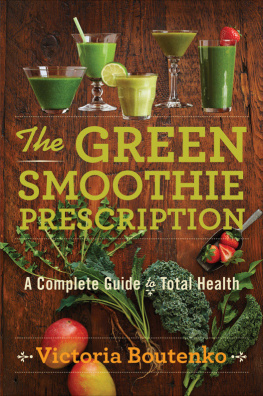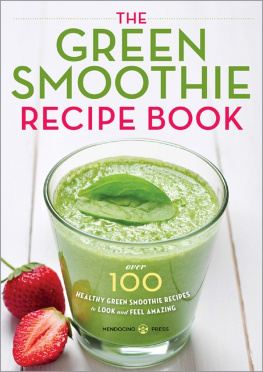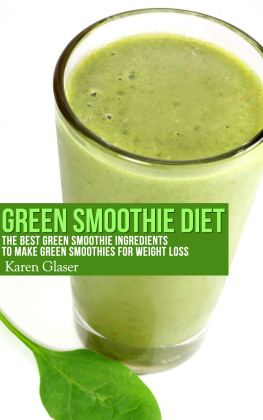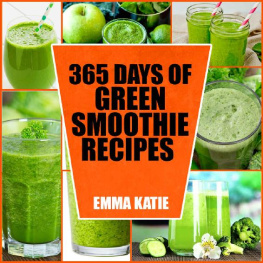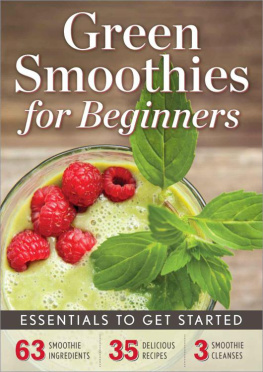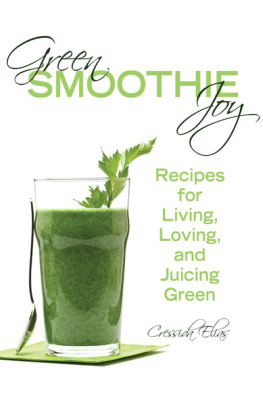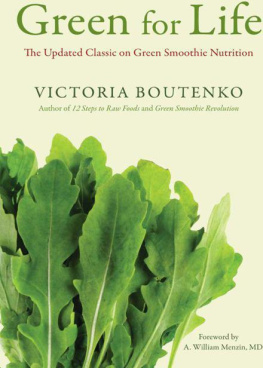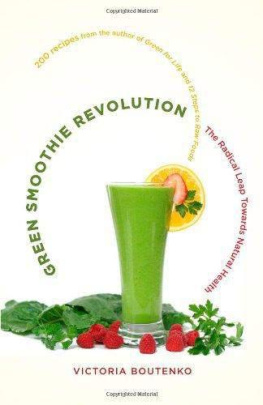To all those who dare to take a stand for their own health.
Contents
Dear reader,
Do you eat enough greens? If you dont know, I have more questions for you. Do you hiccup regularly? Do you sigh a lot? Do you have painful knots in your back? Is your vision blurry? Do you have lots of wrinkles? Do you crave chocolate all the time? If you answer yes to any of these seemingly unimportant questions, youre probably not eating enough greens.
Dark leafy greens contain an astonishing abundance of nutrients that are vital to good health. However, since the beginning of the industrial revolution two hundred years ago, the diet of people in the Western world has undergone a dramatic change: they almost completely stopped consuming fresh greens, along with the proper amount of fresh fruits and other vegetables, and added lots of refined and canned products. Processed foods, as we know now, not only lack important nutrients, but also contain preservatives and many other chemicals harmful to our health.
As a result, people started acquiring countless nutrient deficiencies, which increased from generation to generation, inevitably causing serious health problems. Certain groups of people who sustained themselves mostly on processed and refined products developed such severe diseases as scurvy, rickets, beriberi, and pellagra. Today we know that pellagra is caused by a chronic lack of niacin (vitamin B3), and scurvy is a result of vitamin C deficiency and can be cured by simply eating limes. However, by the end of the nineteenth century these ailments continued to take many thousands of human lives year after year. For example, in 1915, more than 10,000 people died of pellagra in the United States alone.
As we continue to consume a lot of processed foods, the deterioration of our health continues today. Astonishingly, 133 million Americansalmost 1 out of every 2 adultshave at least one chronic illness.
Every human being, just like every other creature on the planet, has the right to health. This is our natural state. And yet something is amiss; were not as healthy as we deserve to be. So how do we return our health to its natural state? Could it be leafy green vegetables?
During the last two decades, there has been a noticeable increase in the amount of global research on the health benefits of greens. American nutritionists now recommend three to five servings of greens daily. This might sound like a lot at first, and I understand why some might think its difficult to consume a healthy amount of greens per day, especially if youre trying to do it through salads alone. Children, in particular, dont want to eat salads, and adults get bored eating the same thing at every meal. Thats why I believe green smoothies are the perfect solution to lasting good health.
Green smoothies are the easiest, fastest, and most delicious way to consume the amount of greens necessary to sustain a healthy and fun lifestyle.
In August 2004, I created the first green smoothie in my office in Ashland, Oregon. Inspired by many positive comments, I wrote an article titled Ode to Green Smoothie and e-mailed it to everyone in my Internet address book. Almost instantly people responded with raving feedback and detailed testimonials. The number of people who were drinking green smoothies turned into a green smoothie tsunami, which continued to grow throughout the summer.
After that I dedicated a year to thoroughly researching all of the nutritional data available at that time about green smoothies. In October 2005, I published Green for Life, which was literally the only book about green smoothies available until Robyn Openshaw published her Green Smoothies Diet in 2009, nearly four years later. Since then, many other authors have published books about the power of green smoothies.
At first, I was happy about the popularity of green smoothies, as it was my dream to spread the news about this healthy drink to the entire planet. However, I soon discovered that some authors recommended adding sugar, dairy, chocolate, salt, coffee, oils, supplements, and even alcohol to green smoothies, the very ingredients green smoothies are designed to neutralize. As a result, people didnt feel better after consuming green smoothies and published their opinions online, which started to drown out the very real and scientifically sound good news about green smoothies. Rather than helping to spread this good news, many of these new books only confused the issue.
This twist in the course of events disappointed me personally, because I have put a huge amount of time and energy into this research and I strongly believe that if green smoothies are consumed properly, they are nothing but beneficial. By popularizing this healthy drink, we can enable millions of people in the world to significantly improve their health.
Between 2008 and 2013, I conducted nineteen green-smoothie retreats, at which participants consumed only green smoothies for seven days. The outstanding healing effect of green smoothies on more than a thousand participants confirmed the scientific research about the vital role of greens in the human diet. I believe that increasing the daily consumption of fresh greens can help many people restore their health naturally to the way it was when they were years younger, which is why I decided to write The Green Smoothie Prescription, an essential primer for great health that includes all of the best available scientific data about the benefits of green vegetables. But its not just science. There are also delicious recipes, inspiring success stories, and personal anecdotes about my life living on greens.
I hope this book will inspire you to include green smoothies in your daily meals. With this, I raise a cup of green smoothie to your health!
Victoria
The greatest obstacle to discovery is not ignoranceit is the illusion of knowledge. DANIEL J. BOORSTIN
M ost of our habits and beliefs about food are shaped in early childhood. In my research I came upon studies about childhood imprinting. Flavors in a mothers milk, I was amazed to learn, shape a babys later food preferences.
That is why different nationalities have different food preferences. People in Asia, for example, eat a lot of rice. Latin Americans swear by corn, Russians adore bread, Italians enjoy spaghetti, and so on. Food choices are even more diverse when it comes to appetizers. One group feasts on caviar and raw fish. Another savors oysters, snails, or countless other rarities. It is interesting that each group might find another groups delicacies disgusting. Still, we continue to cling to our distinctive food choices as if they were the only way to eat. It happens because our food preferences are ingrained in us, literally.
When I was young, my father worked as a pharmacist. At home, in a small chest, among gauze pads, bandages, and cotton balls, he kept two main medicines with which he treated all of our familys health problems. I recall that my father gave us aspirin if we had a fever, which happened approximately once a year, and another bitter-tasting pill if we had a sore throat or any other pain. I remember that those treatments occurred routinely, and I never questioned their validity and was certain that all people did the same. I appreciated their convenience but wondered how these medical drugs worked. My father, even being a pharmacist, could not explain to me how a tiny pill placed into a mouth could control the pain in a completely different part of the body.
As part of his profession, my father studied medicinal herbs and taught my little brother and me about the restorative powers of pine needles, nettles, dandelions, sorrel, golden root, chaga mushrooms, and various other medicinal plants.

